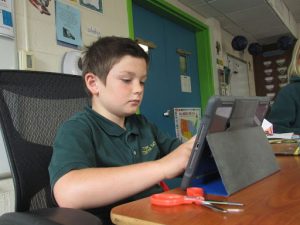Embracing Joy and Gratitude: Navigating Holiday Stress with a Christ-Centered Perspective
Excitement and joy fill the air during the Christmas season. It is also natural to feel a sense of stress. For parents, juggling the demands of the season while ensuring their children thrive academically, spiritually, and emotionally can be challenging. However, even in the busiest of times, we can find joy and gratitude by keeping Christ at the center of the season. Looking for some tips to help your family navigate this holiday season with a sense of peace and purpose?
Pause and Reflect
Amidst the hustle and bustle, take a moment to pause and reflect on the true meaning of the season. Remind your children that Christmas is a celebration of the birth of Jesus Christ, our Savior.
Create Meaningful Traditions
Incorporate Christ-centered traditions that bring your family together. Reading the Nativity story, volunteering at a local charity, or creating handmade gifts for loved ones foster a sense of community and connection. Building these traditions can create lasting memories and help shift the focus from materialism to the true meaning of Christmas.
Practice Mindful Gratitude
Inspire a culture of gratitude within your family by regularly acknowledging and appreciating the little things. A thankful heart is a joyful heart and this perspective shift can help alleviate stress. Create a Gratitude Journal where everyone can jot down things they are thankful for each day. This practice not only promotes a positive mindset but also helps children recognize the abundance of blessings in their lives. Reading the journal as a family is a wonderful dinnertime activity.
Set Realistic Expectations
Manage expectations for the Christmas season, for yourself and your children. It’s okay to decline invitations and prioritize quality time with family. Encourage open communication with your children about their expectations, helping them understand that the joy of Christmas is not solely dependent on extravagant gifts or elaborate festivities.
Extend Kindness Beyond Your Home
Challenge your family to spread kindness in your community. Baking cookies for neighbors, writing encouraging notes to friends, participating in community service projects and other small acts of kindness can have a profound impact. Emphasize the importance of giving back by helping your children experience the joy that comes from serving others.
Let’s embrace the true spirit of Christmas – a season of love, joy, and gratitude. By incorporating these tips into your family’s traditions, you can create a Christ-centered environment that fosters well-rounded, spiritually grounded, and positively impactful children. May your season be filled with the warmth of God’s love and the joy of shared moments with your loved ones.
Blessings!
Mrs. Reinholt

















 With the Christmas season upon us, it is natural for children to imagine what gifts they might receive. At a time when so many ads are targeted towards children for toys, games, and “things,” how do we teach children to be grateful for what they have? For more than just things? An attitude of gratitude can be helpful to a child’s well-being throughout their life. Understanding thankfulness, and truly being able to recognize their many blessings, helps establish a foundation for a joyful disposition.
With the Christmas season upon us, it is natural for children to imagine what gifts they might receive. At a time when so many ads are targeted towards children for toys, games, and “things,” how do we teach children to be grateful for what they have? For more than just things? An attitude of gratitude can be helpful to a child’s well-being throughout their life. Understanding thankfulness, and truly being able to recognize their many blessings, helps establish a foundation for a joyful disposition.  Selecting a school for your child may be one of the most significant investments you make. Just like families, schools have personalities, visions, passions, missions, that must be a good match for your family in order for the partnership to work. In my conversations with families, many questions arise as the family seeks to learn about our school and I seek to introduce them to our offerings. The following, big picture questions typically arise as parents decide on their school choice.
Selecting a school for your child may be one of the most significant investments you make. Just like families, schools have personalities, visions, passions, missions, that must be a good match for your family in order for the partnership to work. In my conversations with families, many questions arise as the family seeks to learn about our school and I seek to introduce them to our offerings. The following, big picture questions typically arise as parents decide on their school choice. by Jennie Farrant, Reading Teacher
by Jennie Farrant, Reading Teacher
 At The Christ School we are committed to developing great learners. One of the primary attributes of great learners is that they have a growth mindset. So many people are quick to say they cannot do something or they lack the natural innate ability to be successful in different areas of their lives. As an educator, I see this in children all the time. Children will say they aren’t smart, or they “just aren’t good at math”. The truth is no one knows what a child can accomplish with the proper training, strategies, and effort. Despite this truth, children and adults often identify areas where a child does not start off strong and prematurely decide the child cannot or will not be successful in that area.
At The Christ School we are committed to developing great learners. One of the primary attributes of great learners is that they have a growth mindset. So many people are quick to say they cannot do something or they lack the natural innate ability to be successful in different areas of their lives. As an educator, I see this in children all the time. Children will say they aren’t smart, or they “just aren’t good at math”. The truth is no one knows what a child can accomplish with the proper training, strategies, and effort. Despite this truth, children and adults often identify areas where a child does not start off strong and prematurely decide the child cannot or will not be successful in that area.  Read to your young child often. When your child can read on their own, take turns reading the chapters.
Read to your young child often. When your child can read on their own, take turns reading the chapters.